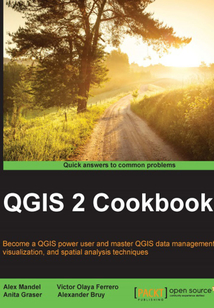舉報 

會員
QGIS 2 Cookbook
最新章節:
Index
IfyouareanintermediateGISuser,witheitherpreviousexperienceinQGISoranyotherGISapplication,thisisthebookforyou.TherecipescanbeusedtolearnmoreadvancedtechniquesinQGISortoreplicatethefunctionalitiesequivalenttootherGISplatforms.ThisbookassumesthatyoualreadyhaveaworkingQGISsysteminplace.
目錄(148章)
倒序
- coverpage
- QGIS 2 Cookbook
- Credits
- About the Authors
- About the Reviewers
- www.PacktPub.com
- eBooks discount offers and more
- Preface
- What this book covers
- What you need for this book
- Who this book is for
- Sections
- Conventions
- Reader feedback
- Customer support
- Chapter 1. Data Input and Output
- Introduction
- Finding geospatial data on your computer
- Describing data sources
- Importing data from text files
- Importing KML/KMZ files
- Importing DXF/DWG files
- Opening a NetCDF file
- Saving a vector layer
- Saving a raster layer
- Reprojecting a layer
- Batch format conversion
- Batch reprojection
- Loading vector layers into SpatiaLite
- Loading vector layers into PostGIS
- Chapter 2. Data Management
- Introduction
- Joining layer data
- Cleaning up the attribute table
- Configuring relations
- Joining tables in databases
- Creating views in SpatiaLite
- Creating views in PostGIS
- Creating spatial indexes
- Georeferencing rasters
- Georeferencing vector layers
- Creating raster overviews (pyramids)
- Building virtual rasters (catalogs)
- Chapter 3. Common Data Preprocessing Steps
- Introduction
- Converting points to lines to polygons and back – QGIS
- Converting points to lines to polygons and back – SpatiaLite
- Converting points to lines to polygons and back – PostGIS
- Cropping rasters
- Clipping vectors
- Extracting vectors
- Converting rasters to vectors
- Converting vectors to rasters
- Building DateTime strings
- Geotagging photos
- Chapter 4. Data Exploration
- Introduction
- Listing unique values in a column
- Exploring numeric value distribution in a column
- Exploring spatiotemporal vector data using Time Manager
- Creating animations using Time Manager
- Designing time-dependent styles
- Loading BaseMaps with the QuickMapServices plugin
- Loading BaseMaps with the OpenLayers plugin
- Viewing geotagged photos
- Chapter 5. Classic Vector Analysis
- Introduction
- Selecting optimum sites
- Dasymetric mapping
- Calculating regional statistics
- Estimating density heatmaps
- Estimating values based on samples
- Chapter 6. Network Analysis
- Introduction
- Creating a simple routing network
- Calculating the shortest paths using the Road graph plugin
- Routing with one-way streets in the Road graph plugin
- Calculating the shortest paths with the QGIS network analysis library
- Routing point sequences
- Automating multiple route computation using batch processing
- Matching points to the nearest line
- Creating a routing network for pgRouting
- Visualizing the pgRouting results in QGIS
- Using the pgRoutingLayer plugin for convenience
- Getting network data from the OSM
- Chapter 7. Raster Analysis I
- Introduction
- Using the raster calculator
- Preparing elevation data
- Calculating a slope
- Calculating a hillshade layer
- Analyzing hydrology
- Calculating a topographic index
- Automating analysis tasks using the graphical modeler
- Chapter 8. Raster Analysis II
- Introduction
- Calculating NDVI
- Handling null values
- Setting extents with masks
- Sampling a raster layer
- Visualizing multispectral layers
- Modifying and reclassifying values in raster layers
- Performing supervised classification of raster layers
- Chapter 9. QGIS and the Web
- Introduction
- Using web services
- Using WFS and WFS-T
- Searching CSW
- Using WMS and WMS Tiles
- Using WCS
- Using GDAL
- Serving web maps with the QGIS server
- Scale-dependent rendering
- Hooking up web clients
- Managing GeoServer from QGIS
- Chapter 10. Cartography Tips
- Introduction
- Using Rule Based Rendering
- Handling transparencies
- Understanding the feature and layer blending modes
- Saving and loading styles
- Configuring data-defined labels
- Creating custom SVG graphics
- Making pretty graticules in any projection
- Making useful graticules in printed maps
- Creating a map series using Atlas
- Chapter 11. Extending QGIS
- Introduction
- Defining custom projections
- Working near the dateline
- Working offline
- Using the QspatiaLite plugin
- Adding plugins with Python dependencies
- Using the Python console
- Writing Processing algorithms
- Writing QGIS plugins
- Using external tools
- Chapter 12. Up and Coming
- Introduction
- Preparing LiDAR data
- Opening File Geodatabases with the OpenFileGDB driver
- Using Geopackages
- The PostGIS Topology Editor plugin
- The Topology Checker plugin
- GRASS Topology tools
- Hunting for bugs
- Reporting bugs
- Index 更新時間:2021-07-16 11:13:24
推薦閱讀
- HTML5+CSS3王者歸來
- Git Version Control Cookbook
- FreeSWITCH 1.8
- 摩登創客:與智能手機和平板電腦共舞
- Flux Architecture
- PLC應用技術(三菱FX2N系列)
- Visualforce Developer’s guide
- 從零開始學Python網絡爬蟲
- 大學計算機基礎實驗指導
- Extending Docker
- Building Microservices with Go
- Mastering Vim
- Python GUI設計tkinter菜鳥編程(增強版)
- Node.js進階之路
- Instant Highcharts
- Spring Cloud微服務架構開發實戰
- Mastering iOS Game Development
- Hadoop技術內幕:深入解析HadoopCommon和HDFS架構設計與實現原理
- HTML5 for Flash Developers
- C語言開發從入門到精通
- HTTP權威指南
- 程序設計基礎(C語言)實驗指導與測試(第2版)
- 零基礎學Python(第2版)
- Scala并發編程(第2版)
- JavaScript and JSON Essentials
- Building an RPG with Unreal
- SAFe 4.0參考指南:精益軟件與系統工程的規模化敏捷框架
- Python深度學習:邏輯、算法與編程實戰
- 點睛:ActionScript3.0游戲互動編程
- 青少年軟件編程基礎與實戰(圖形化編程四級)

